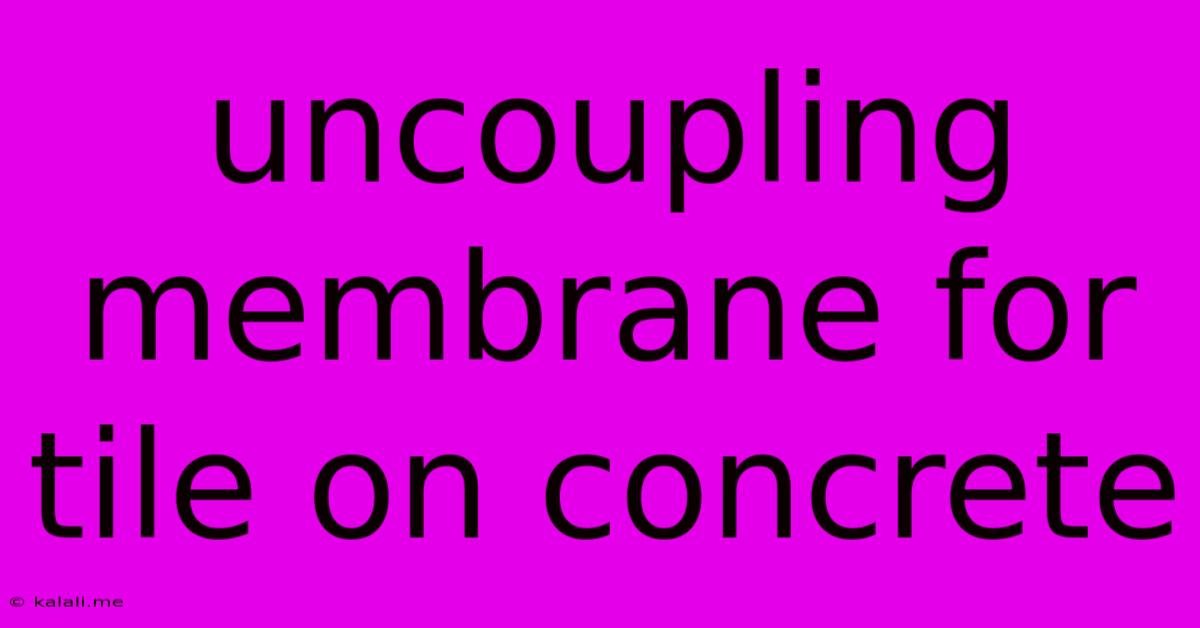Uncoupling Membrane For Tile On Concrete
Kalali
Jun 08, 2025 · 3 min read

Table of Contents
Uncoupling Membranes for Tile on Concrete: A Comprehensive Guide
Meta Description: Learn everything about uncoupling membranes for tile installations on concrete. This guide covers their benefits, types, installation, and troubleshooting, ensuring a successful and long-lasting tile project.
Installing tile directly onto concrete can lead to cracked tiles and grout lines, especially in areas prone to movement or settling. This is where an uncoupling membrane becomes essential. An uncoupling membrane is a layer placed between the concrete substrate and the tile, decoupling the tile from the underlying surface. This prevents cracks and imperfections in the concrete from transferring to the tile, resulting in a more durable and aesthetically pleasing finish. This comprehensive guide dives deep into the world of uncoupling membranes, covering everything you need to know for a successful tile installation.
What are the Benefits of Using an Uncoupling Membrane?
Using an uncoupling membrane offers numerous advantages over direct tile application on concrete:
- Crack Isolation: The primary benefit is its ability to isolate the tile from cracks and movement in the concrete substrate. This dramatically increases the lifespan of your tile installation.
- Improved Tile Longevity: By absorbing minor movements and stress, the membrane protects your tiles from cracking or chipping.
- Leveling Uneven Surfaces: Many uncoupling membranes offer slight leveling capabilities, making them suitable for minor imperfections in the concrete floor.
- Moisture Management: Certain types of uncoupling membranes also offer excellent moisture protection, preventing water damage and mold growth.
- Increased Sound Insulation: Some membranes provide enhanced sound insulation, reducing noise transmission.
- Improved Flexibility: The membrane allows for greater flexibility in the tile installation, especially important in areas with significant movement.
Types of Uncoupling Membranes
Several types of uncoupling membranes are available, each with its own characteristics and applications:
- Mat-Based Membranes: These are commonly used and come in various thicknesses and materials. They often feature a textured surface for improved mortar adhesion.
- Sheet-Based Membranes: Similar to mat-based membranes but offer a smoother surface. They are often preferred for larger format tiles.
- Liquid-Applied Membranes: These are applied as a liquid and cure to form a flexible membrane. They are ideal for complex shapes and hard-to-reach areas.
How to Install an Uncoupling Membrane
The installation process is relatively straightforward but requires careful attention to detail:
- Prepare the Substrate: Ensure the concrete is clean, dry, and free of debris. Repair any significant cracks or imperfections.
- Prime the Substrate: Apply a suitable primer to improve adhesion.
- Install the Membrane: Follow the manufacturer's instructions carefully. This typically involves rolling out the membrane, ensuring proper overlap and securing it with adhesive.
- Apply Thinset Mortar: Apply a thin layer of modified thinset mortar to the membrane.
- Install the Tiles: Install tiles as per standard procedures, ensuring proper spacing and grouting.
Troubleshooting Common Issues
Despite careful installation, problems can sometimes arise:
- Membrane Wrinkles: These can be caused by improper application or substrate irregularities. Smooth them out carefully before applying mortar.
- Poor Adhesion: Ensure proper substrate preparation and primer application. Use a suitable adhesive designed for uncoupling membranes.
- Tile Cracking: This is less likely with a properly installed membrane but can still happen due to extreme substrate movement or improper installation techniques.
Conclusion
Investing in an uncoupling membrane is a worthwhile decision for any tile installation on concrete. It significantly increases the longevity and durability of your tile project, providing peace of mind and a beautiful, long-lasting finish. By understanding the benefits, types, and installation process of uncoupling membranes, you can ensure a successful and problem-free tile installation. Remember to always refer to the manufacturer's instructions for specific details and recommendations for your chosen product.
Latest Posts
Latest Posts
-
How To Turn Off Roaming In Android
Jun 09, 2025
-
Why Does My Bathroom Sink Water Smell Like Rotten Eggs
Jun 09, 2025
-
How To Flip An Image In Ps
Jun 09, 2025
-
How Did The Weasleys Get Scabbers
Jun 09, 2025
-
What Does It Mean To Be In Spirit
Jun 09, 2025
Related Post
Thank you for visiting our website which covers about Uncoupling Membrane For Tile On Concrete . We hope the information provided has been useful to you. Feel free to contact us if you have any questions or need further assistance. See you next time and don't miss to bookmark.